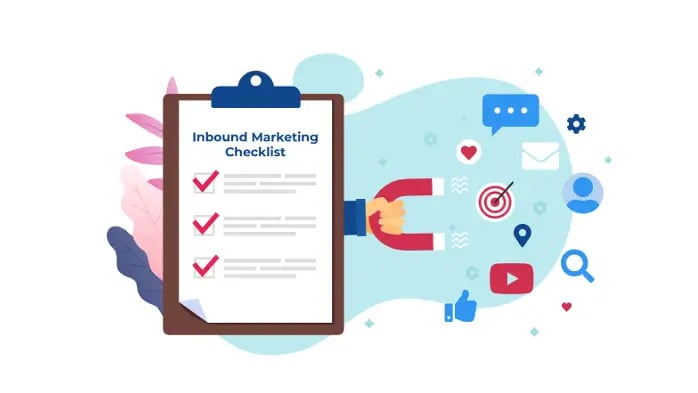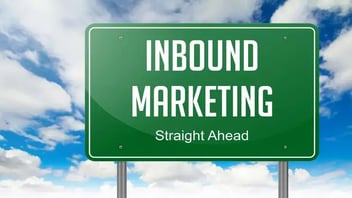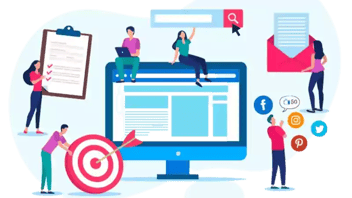What is Inbound Marketing and Why Does It Matter?
As a business owner or marketing professional, you aim to ramp up your marketing and sales efforts, expand your online visibility, and scale your business growth. Perhaps words such as content or inbound marketing have come your way, but you're wary of industry jargon and have no desire to invest your valuable time in a fleeting trend.
Perhaps you've tried some inbound marketing methods, like running a blog or increasing your social media presence.

One of the more recent marketing tactics to have staying power is what's known as Inbound Marketing.
Inbound marketing is a marketing methodology that focuses on attracting potential customers or leads through the creation and distribution of valuable and relevant content, rather than interrupting them with unsolicited promotions or advertisements.
How Does Inbound Marketing Work?
-
Inbound marketing helps generate three times more leads than outbound marketing. Every dollar you spend on inbound marketing generates three times more leads than if you spent that same dollar on outbound marketing. Inbound marketing is a strategic approach and a more cost-effective way to generate leads and customers. [Source: HubSpot]
-
72% of B2B buyers start their buying journey with online research. Your potential customers are already online, looking for information about your products or services. Inbound marketing can help you reach them at the right time with valuable content and help them move through the buying process. [Source: Content Marketing Institute]
-
Inbound marketing can increase website traffic by 120%. Inbound marketing and SEO can help you generate more website traffic, leading to more leads and customers. [Source: HubSpot]
-
Inbound marketing can increase sales by 25%. Inbound marketing is a great way to improve your sales and marketing, grow your business's revenue, and increase your marketing return on investment (ROI). [Source: HubSpot]
The primary goal of using inbound marketing is to build trust, credibility, and brand awareness by offering helpful information with various types of content that solve the target audience's problems, educate them about relevant topics, and address their pain points.
The benefit of digital marketing is that you can A/B test, so don't be afraid to experiment with content topics, formats, and channels.
Inbound is about pulling in your audience in with relevant, timely, and engaging content and conversations on social media and creating customers for life by delighting them with your knowledge and service. This contrasts with outbound marketing efforts, which are about pushing your products and offerings to your customers using print advertising, TV ads, billboards, and other (often costly) paid options.
The key to Inbound Marketing is a human-centered approach. Inbound marketing is a methodology that takes time. This is not a method to use if you're out for quick sales or fast turnaround. The inbound methodology is a strategy that focuses on cultivating relationships with your customers, starting before they are customers and reaching them when they search the internet for a solution. That's why people search online; they have a problem and need a solution.
Inbound marketing aims to be there with the answers, positioning yourself and your company as a knowledgeable source of quality information.
Then, when these same people are ready to buy/hire, they already have your name in mind and will seek you out without any direct action on your part.
What Type of Marketing is Inbound?
Inbound marketing is a strategy considered a pull marketing strategy. Inbound marketing is a way to attract customers to your business rather than pushing your products or services onto them. Instead of interrupting their experience with ads, you offer engaging content and experiences that resonate with their needs and interests.
Here are some critical characteristics of an inbound strategy that differentiate it from push marketing strategies:
-
Focuses on content creation: Inbound marketing relies on creating informative and engaging content across various platforms, such as blog posts, ebooks, infographics, videos, and social media posts. This content is designed to attract customers, educate them about your brand, and build trust.
-
Tailored to the customer journey: Inbound marketing takes a holistic approach to the customer journey, from awareness to advocacy. By providing content at each stage of the buyer's journey, you can guide potential customers toward conversion and ultimately turn them into loyal advocates.
-
Utilizes organic reach: Inbound marketing amplifies content through organic channels like search engines, social media, and word-of-mouth marketing. This allows you to reach a wider audience and build a long-term brand presence.
-
Prioritizes engagement: Inbound marketing emphasizes building relationships with potential customers by encouraging interaction with your content. This can be done through comments, social media conversations, email subscriptions, and other forms of engagement.
-
Data-driven approach: Inbound marketing techniques rely heavily on data to measure effectiveness and track progress. By analyzing website traffic, conversions, and other key metrics, you can see what's working and what's not and adjust your strategy accordingly.
Here are some of the main types of inbound marketing tactics across a number of marketing channels:
- Content marketing: Creating relevant content across many platforms, including blog posts, articles, infographics, videos, and ebooks.
-
Social media marketing: Engaging with your target audience on social media platforms and promoting your content.
-
Search engine optimization (SEO): Optimizing your website and content for search engines to improve organic visibility.
-
Email marketing: Building an email list and sending targeted email campaigns to nurture leads and promote your brand.
-
Landing page optimization: Creating landing pages designed to convert visitors into leads.
-
Call to action (CTA) implementation: Encouraging visitors to take specific actions, such as subscribing to your email list, downloading an ebook, or contacting you directly.
The Key Stages of Inbound Marketing
The inbound marketing methodology looks at three phases arranged in a flywheel: Attract, Engage, and Delight.
Let's review the inbound marketing approach, how inbound marketing works, and how we can develop an inbound marketing strategy and integrate it into our business practices:

1. The Attract stage
You'll spend the most time on this stage, but don't worry; you'll work with customers at all stages and at various times. This stage includes defining your target audience and ongoing efforts like helpful content creation, social media presence, and interactions with clients and potential clients.
The attract stage boils down to relevant, engaging content and timeliness. Or, to put it another way, being in the right place at the right time. In this context, that means having your content out there and searchable. You'll use your Search Engine Optimization (SEO) skills, analytics, and creativity.
The attract stage begins the buyer's journey, and your primary inbound marketing effort will be content creation. This can take several forms:
-
Blog posts. Blogging is a foundational piece of any inbound marketing campaign. It transcends individual campaigns and forms the base of a solid marketing effort in general. Posts that address the pain points of your customers and the goings on in your industry that are generally relevant and interesting will serve you well in the future. Video content and appropriate inbound marketing content can be beneficial when explaining possible solutions.
-
Social media presence. By cultivating a following on social media, you have a pool of interested followers to draw on. Share their posts, retweet their funny tweets, and in return, they'll share, like, and retweet yours. Mine their feeds for additional questions or pain points you can address with more in-depth blog posts. Then, be sure to mention the person you got the idea from when you post so they'll be excited to read and share that content.
-
Gated content. Once you have a solid following of readers, you can start creating more explicit content like downloadable, gated PDFs, ebooks, or webinars. When someone signs up for this content, you capture their contact information and build your email list. Now, you're providing even more valuable information to your audience, and they're allowing you to market to them via an email newsletter, special offers, etc.
That last piece, the collection of customers (albeit potential ones, at this point), is crucial to the second stage of a successful inbound marketing strategy:
2. The Engage stage
The engagement stage begins when you collect that contact information. It then follows your audience through the funnel and into their becoming happy customers. You'll notice we didn't say it ended there. That's because the engagement you start when you collect a new person's contact info never ends. Use email marketing and marketing automation combined with your established trust to keep them updated on your industry, for example, giving them special holiday offers or offering customer referral bonuses.
This stage also encompasses your interactions with social media followers. You're solidifying your reputation by being consistent in your content offerings, implementing effective strategies to engage with followers as your authentic self, and being open and honest in your dealings with the public. And in the world of inbound marketing, your reputation is gold. It's what generates the goodwill your customers have toward you. It makes them actively want to spread your marketing content to their followers and friends by word of mouth.
And it's what you'll be relying on as prospects enter the third and final stage of the inbound marketing journey:
3. The Delight stage
We'll be honest; this is our favorite stage. What's not to love about delighting your customers, right? The delight stage begins once the deal is signed and your follower has become a customer. Your job is now to work tirelessly to keep them happy.
"I am happy with you and your company and your service."
This means, once again, staying on top of your social media marketing and maintaining your interactions with followers (some of whom are now in this stage of their journey as happy customers). This also means you're providing these folks with the best service/widget you can (this isn't our focus; we're assuming you're already on top in your field; that way, we can focus on our field of inbound marketing).
And there you are; you've taken your customer on a full-circle inbound marketing journey. From random strangers on the internet who found your content because it helped them solve their problem, down the funnel to the happy customer with whom you're still actively engaging on social media. By keeping yourself and your stellar service in front of your audience, you're ensuring they remember you when they need you again and that they're recommending you to all their friends—and that's what an effective inbound marketing strategy is all about.
Create the opportunity for customers to provide feedback as a critical form of engagement and to understand if your services are, in fact, as delightful as you would like them to be.
What are Inbound Marketing Examples?
Inbound marketing is about attracting customers to your business by providing valuable, different types of content and experiences that address their needs and interests on channels relevant to your audience. Here are some examples of inbound marketing:
Content creation:
-
Blogs: Regularly publish informative and engaging blog posts on topics relevant to your target audience. This demonstrates expertise, attracts organic search traffic, and builds trust with potential customers.
-
Infographics: Create visually appealing infographics that summarize complex information in an easy-to-understand format. Infographics are shareable and can drive traffic back to your website.
-
Ebooks and white papers: Offer in-depth guides and reports on specific topics in exchange for contact information. This helps you capture leads and nurture them into paying customers.
-
Podcasts and video series: Develop engaging audio or video content that educates and entertains your audience. Podcasts and video series can build brand awareness and foster long-term relationships with potential customers.
Social media engagement:
-
Actively participate in relevant social media groups and communities. Share valuable content, answer questions, and converse with potential customers.
-
Run social media contests and giveaways. This is a great way to generate excitement, attract new followers, and collect valuable contact information.
- Utilize social media advertising to target specific audiences with laser precision.
Search engine optimization (SEO):
-
Optimize your content and meta tags for relevant keywords. This will help your website rank higher in search engine results pages, making it easier for potential customers to find you.
-
Build backlinks to your website from high-quality websites. This will improve your website's authority and ranking in search results.
-
Utilize local SEO strategies to attract local customers.
Email marketing:
-
Build an email list and segment it based on your audience's interests and needs.
-
Send regular email newsletters with valuable content, offers, and updates.
-
Develop automated email campaigns that nurture leads and move them closer to conversion.
Other inbound marketing examples:
-
Webinars and online events.
-
Interactive quizzes and assessments.
-
Free online tools and resources.
-
Case studies and testimonials.
-
Community forums and online support groups.
Some real-world examples of successful inbound marketing campaigns:
-
Spotify's Wrapped campaign: This annual campaign uses data to personalize the user experience and generate excitement and engagement.
-
HubSpot's blog: HubSpot is a leading provider of inbound marketing software, and its blog is a go-to resource for marketers worldwide.
-
Dollar Shave Club's viral video: This humorous video went viral and helped Dollar Shave Club build a loyal customer base.
-
Moz's Whiteboard Friday series: This series of whiteboard videos offers insightful and entertaining SEO tips.
- Slack's community forum: Slack's community forum is a valuable resource for users and helps build brand loyalty.
This content is also available in:
- Deutsch: Was ist Inbound-Marketing und warum ist es wichtig?
- Español: ¿Qué es el Inbound Marketing y por qué es importante?
- Français: Qu'est-ce que l'inbound marketing et pourquoi est-ce important?
- Italiano: Cos'è l'Inbound Marketing e perché è importante?
- Română: Ce este Inbound Marketing și de ce este important?
- 简体中文: 什么是入站营销以及为什么它很重要?









Leave a Comment